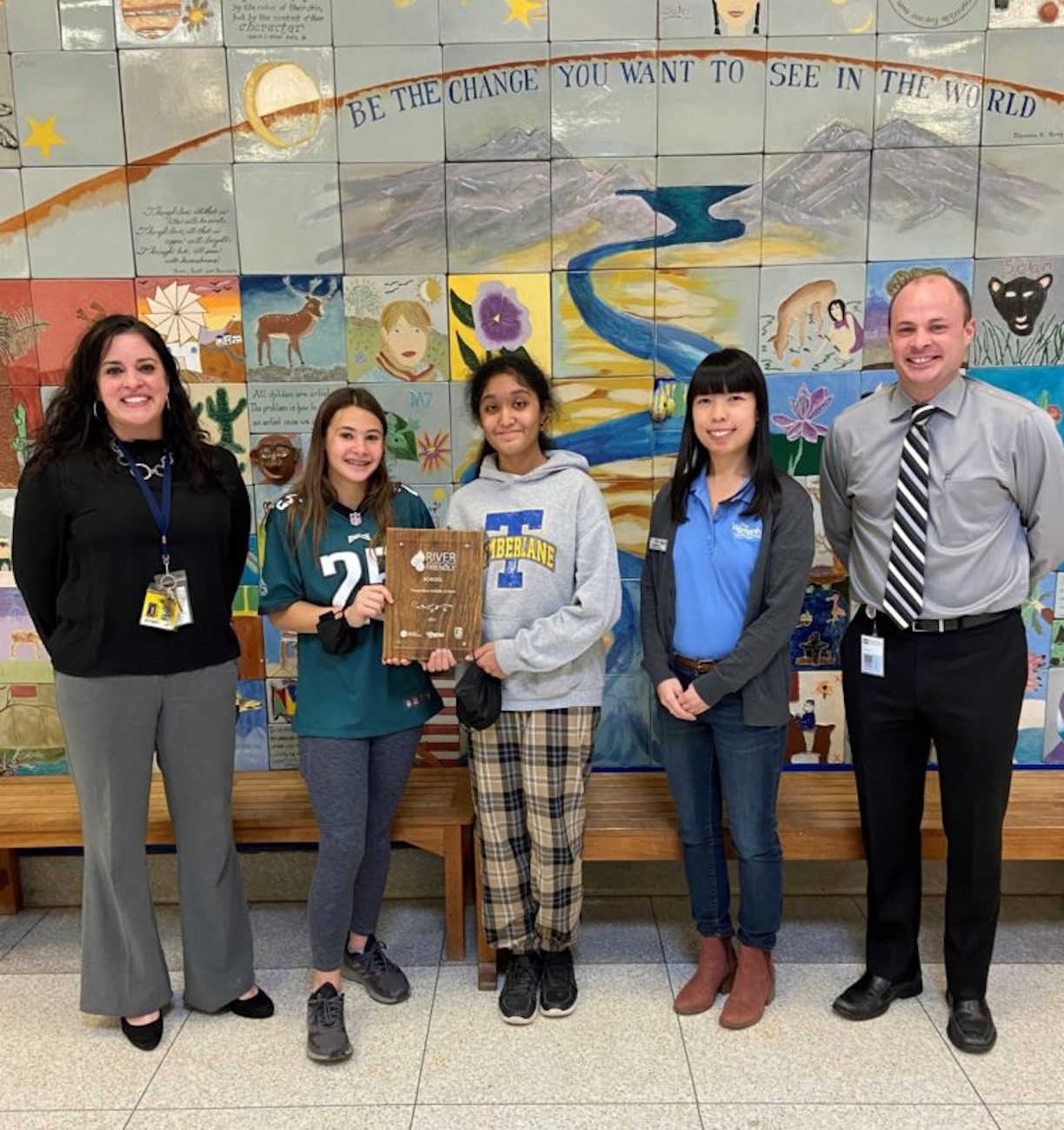The Hopewell Valley School District (HVRSD) has become the first in New Jersey to gain “River-Friendly” certification, further instilling an environmental ethos in its students, staff and faculty.
From building pollinator gardens and nature trails to designing hands-on science lessons, River-Friendly schools create curriculum, projects, and outreach that feature water conservation, wildlife and habitat enhancement, water quality, and educational outreach. The District-wide accreditation also connected the schools as they each worked toward a unified mission.
“I am delighted we were finally able to achieve the certification for River-Friendly schools across the District,” said HVRSD Superintendent Dr. Rosetta Treece. “We are teaching the kids how important it is to protect our waterways. Small changes do make big changes and we need to think as a district about some of the larger changes that we can make. This is one step in that direction.”
A District-wide celebration took place on Wednesday, April 13 at Timberlane Middle School with teachers and staff from all of the schools, as well as students representing school clubs such as the Green Team and Youth Environmental Society. Dr. Treece, STEM Director Scott Brettell, Jim Waltman, executive director of The Watershed Institute, and TMS Principal Nicole Gianfredi spoke at the event. Dr. Treece received a proclamation from U.S. Representative Bonnie Watson Coleman, D-NJ 12th District, praising the school district’s dedication to environmental stewardship and education. Elected officials and other environmental nonprofits joined in the celebration.
The Watershed, which runs the River-Friendly certification programs, provided guidance, staff support and certification in the multi-year process at each school.
“We are thrilled by the Hopewell Valley schools’ dedication to water and environmental issues and for instilling that mindset in students,” said River-Friendly Coordinator Olivia Spildooren.
The District’s fresh look at how students connect to the environment is timely as New Jersey is the first in the nation to adopt climate change into its public school curriculum. The State’s learning standards, which go into effect more broadly next fall, prepare students to understand how and why climate change happens, the impact it has on our local and global communities, and to act in informed and sustainable ways.
Teachers at the District’s six schools added new lessons and led their students as they created or improved existing habitats outside on their campuses. The schools also did public outreach and education, ranging from a virtual science fair focused on water conservation to sharing information on how plastic pollution impacts human health and wildlife. Each school worked separately and tailored the River-Friendly criteria to its students during a multi-year process.
STEM Facilitator at Bear Tavern Elementary School said Tina Overman said students there created a nature trail, pollinator gardens, meadow, and other features on the school’s campus. The students raise trout and terrapin, and have installed bat and bird boxes. She said the River-Friendly certification process provided a roadmap and helped identify gaps in the STEM curriculum. She said she also appreciated the support and resource of Watershed staff.
Overman explained: “Having it all laid out for us made it easier to follow and also identify what was missing. The River-Friendly certification keeps us moving us on this track of ‘are we doing enough with this land and community around us?’”

Nicole Gianfredi, the principal of the Timberlane Middle School, said the process helped “build community” among the school’s in-person and remote student cohorts during the COVID-19 pandemic. Students watched videos on water conservation, created and shared information on social media, designed informational posters, and educated themselves and their families.
“I thought this was a great way for our community to focus on one common goal,” Ginafredi said, “especially for middle school students, some are knowledgeable and ready to go to educate their peers while others found these ideas were new and they learned a lot and became more mindful. All of our schools in the District are doing this and that universal desire to protect water is what we are all striving toward.”
Helen Corveleyn, the STEM Facilitator at Hopewell Elementary School, said the River-Friendly certification process helped reinvigorate the school’s focus on water conservation and water quality. She said students, who often lunch near Beden Brook, made the connections between snack wrappers and other trash floating in the brook and the health of the water as they counted the water pennies scooped up in a sample during a water-monitoring lesson. “The River-Friendly efforts drew educators’ attention to water as a commodity and resource that we have to protect and educate students about more fully,” she said.
Croveleyn added that students read poetry from author Carole Lindstrom’s book, “We are Water Protectors”, and made connections to the humanities with an environmental twist. “The River-Friendly process infused us with a different energy, she said. “The multidimensional aspect encourages teachers to approach water conservation by thinking outside of the box. When you protect water there are other positive outcomes that you make for the overall ecosystem.”
Several students at Central High School led the River-Friendly certification process. Akhansha Arvind and Nadia Chasalow collaborated with art teacher Carolyn McGrath, who also advises the Youth Environmental Society (YES); Sarah Sherwin, an environmental science teacher; and Principal Trish Riley to gather documentation for the process. The two students wrote and submitted the River-Friendly application themselves, which included descriptions of actions such as the installation of pollinator-friendly native plants, litter clean up through Clean Communities Day, and screening of the films “The Story of Plastic” and “Microplastic Madness”.
The process was “challenging and rigorous,” McGrath said. “It inspired us to think more specifically about the ways that our sustainability efforts relate to water quality and conservation. And it also encouraged us to think about including those aspects in future greening actions.”
The Stony Brook Elementary School launched its River-Friendly efforts with a school-wide assembly so the students gained a framework and context. Stony Brook STEM Facilitator Susan Hammill said the process gave students real-world connections to the climate and environmental lessons.
“The River-Friendly process was thought-provoking,” she said. “This was done in the sense of helping kids and teachers see our connections to the bigger world and to start noticing what is around us in more careful ways. For example, she said that the Stony Brook third graders learned about wildlife habitats and water quality by raising Monarch butterflies. The students discovered the Monarch’s life cycles and food sources. They gathered data by measuring the caterpillars’ length. The project culminated with students tagging the butterflies, tracking the migration to Mexico and sharing the data with University of Oklahoma scientists. “Kids learned that science is ongoing and long-lasting and that eight-year-olds can be scientists who contribute to research,” Hammill explained.
Toll Gate Grammar School explored water through a few lenses. Fifth graders examined plastic pollution and researched how scientists and engineers have designed ways to clean the world’s oceans. All grade levels explored how the Toll Gate’s stormwater runoff system has a negative impact on the health of a nearby stream, said former STEM Facilitator Greg Hunter, who now teaches science in the middle school.
Jocelyn Muzychko, who succeeded Hunter and is the current STEM Facilitator at Toll Gate, said the River-Friendly process helped her examine how to incorporate science and math into what students were already doing. She also introduced simple ways students can help foster environmental change. For example, an entomologist spoke with students about the invasive Spotted lanternfly. Next, the students raised and released praying mantis – a natural predator – around the school to try and reduce the lanternfly populations.

Submitted by The Watershed Institute. Photos by Lisa Wolff, Executive Director of Friends of Hopewell Valley Open Space




